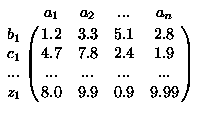
![[Univ of Cambridge]](Matrices_files/uniban-s.gif)

![[Dept of Engineering]](Matrices_files/engban-s.gif)
\textstyle but you can override this
by changing the \displaystyle.
\begin{math}
\begin{array}{clrr} %
a+b+c & uv & x-y & 27 \\
x+y & w & +z & 363
\end{array}
\end{math}
produces 
The rows are arranged so that their centres are aligned. You can align their tops or bottoms instead by using a further argument when you create the array.
\begin{array}{clrr}[t]
would produce top-aligned lines, and `[b]' would produce
bottom-aligned ones. The Delimiters section of this document shows how
to bracket matrices.
TEX has a few maths facilities not mentioned in the LATEX book. The following TEX construction might be useful.
\begin{math}
\bordermatrix{&a_1&a_2&...&a_n\cr
b_1 & 1.2 & 3.3 & 5.1 & 2.8 \cr
c_1 & 4.7 & 7.8 & 2.4 & 1.9 \cr
... & ... & ... & ... & ... \cr
z_1 & 8.0 & 9.9 & 0.9 & 9.99 \cr}
\end{math}
